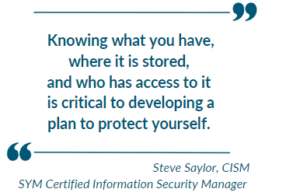Cybersecurity is a complex topic. In many ways, it’s like investing. There are lots of ways to do it, it can be really confusing without good information, and reliable advice from a knowledgeable source is critical. And if you don’t do it right, you are likely to lose your money. Each individual and business is different; the tools and techniques necessary to protect them vary dramatically. An online search may render some “top ten steps” on the topic, but protecting your online assets is more than a simple checklist; it is an ongoing effort. To develop an effective cybersecurity plan, it’s best to sit down with an expert that has your interest in mind and work through your individual situation. There are some basic principles, however, that can be followed to help guide you on the right path. As with any worthy project, the important first step is the prep work. Most people skip this critical planning step and try to jump in with some tactical step, and that can lead to huge holes in your security plan.
Identify what you have worth protecting.
Any good attempt at improving your cybersecurity begins with taking an inventory of your digital assets. Knowing what you have, where it is stored, and who has access to it is critical to developing a plan to protect yourself.
What are your digital assets?
One of the most important digital assets you have is your identity, those unique identifiers that prove who you are and associate you to real physical assets.
- usernames
- passwords
 biometric data
biometric data- Social Security numbers
Digital assets are also private or privileged data,
- banking information
- investment account information
- health records
- employment history
- credit files
- intellectual property
Who else has your digital assets?
Digital assets include the data you share, the information collected by people and companies with which you do business.
- healthcare providers
- insurance companies
- retailers
- search engines
- social media platforms
Over the course of the next few months, we’ll offer some practical advice for how you can manage your inventory and give some practical steps that you can take to protect those digital assets through building an effective cyber security plan. Until then, get started on that prep work and inventory your assets, where they are, and who has access to them.
Curious how SYM approaches Cyber Security and what we do to protect our client’s information? Here’s a link to our Client Information Security Brief that provides some details about our program.
Disclosure: The opinions expressed herein are those of SYM Financial Corporation (“SYM”) and are subject to change without notice. This material is not financial advice or an offer to sell any product. SYM reserves the right to modify its current investment strategies and techniques based on changing market dynamics or client needs. SYM is an independent investment adviser registered under the Investment Advisers Act of 1940, as amended. Registration does not imply a certain level of skill or training. More information about SYM including our investment strategies, fees, and objectives can be found in our ADV Part 2, which is available upon request.



